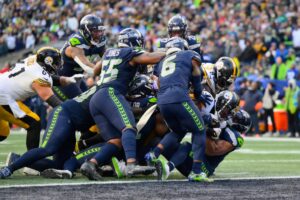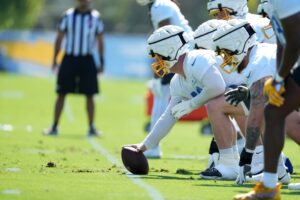A seven win season is a failure by Green Bay Packers standards. However, there is still an air of optimism at 1265 Lombardi Avenue, thanks in part to rookie running backs Jamaal Williams and Aaron Jones. Ever since Eddie Lacy fell off the map following the 2014 season, the Green Bay backfield has been in flux. The team went so far as to transition receiver Ty Montgomery to the role of lead back, but injuries have plagued that experiment since the beginning. Luckily, the 2016 draft offered a bevy of talented tailbacks. The Packers brass recognized the opportunity, and invested three of their seven picks in the position. During training camp, coach Mike McCarthy acknowledged the inexperience in his backfield, but he also pointed out the benefit of carrying three rookie backs.
“That motivation in the room, that’s not normal,” he said. “I think that will be a benefit.” Competition breeds success, and that’s what happened with these running backs.
Aaron Jones, Jamaal Williams Give Green Bay Packers Hope for the Future
When Montgomery went down early in the year, Jones saw a drastic increase in snaps. Having emerged from training camp second on the depth chart, the rookie out of UTEP capitalized on the opportunity to start. Jones had his breakout performance in a memorable comeback victory at the Dallas Cowboys, posting 125 rushing yards and a touchdown on just 19 attempts. His ability to gain yardage kept the play action passing viable throughout the game. Quarterback Aaron Rodgers already trusted Jones enough to give him the ball multiple times on the final drive. Two weeks later, he went over the century mark again against the New Orleans Saints by turning 17 carries into 131 rushing yards and a score. Jones ended the season with an average of 5.5 yards per carry.
The measurable attributes of Aaron Jones transferred very well to the professional level.
This came as no surprise to those who evaluated him. At the combine, Jones showed quickness when he cracked the 86th percentile in the three-cone drill. Some combine drills are more telling than others, but speed and agility translate. Even more impressively, he ranked second among qualifying running backs in yards gained after close in 2017. Yards gained after close is a metric that tells us how many yards, on average, a player gains after a defender gets within one yard. The league average is 3.7, Jones came in at 4.79 yards in his debut season.
After selecting Jones in the fifth round, director of football operations Eliot Wolf remarked on his speed.
“He’s a guy that can consistently beat the angle of the safety,” Wolf remarked. (He broke off) a lot of long runs for UTEP.”
Wolf was no doubt referencing the eight 40+ yard runs Jones broke off in 2016 for the Miners on his way to becoming their all-time leading rusher. Runs like those resulted in a career average of 7.7 yards per carry. Big play ability and lateral speed, as well as the ability to make defenders miss in the open field were skills often noted in the rookie’s scouting reports. When these attributes came to fruition in the pros, it just confirmed what scouts knew all along.
Injury was a concern with Jones, and those fears were eventually realized.
The main concern about Jones coming out of college, and the reason he fell in the draft to 182nd overall is durability. Jones missed 10 games during his junior year at UTEP with a torn ligament in his ankle. Injuries like that are red flags to general managers in the NFL. In week 10 at the Chicago Bears, injury derailed his impressive rookie season completely. In the first quarter, Jones was carted off the field with a sprained MCL. He would return to action in week 13 for one snap against the Tampa Bay Buccaneers. Jones made the most of that opportunity as well by winning the game with his 20-yard touchdown run. The rookie would see minimal action going forward, but the volume was gone. The starting job belonged almost entirely to Williams at that point.
Jamaal Williams came up big when he was needed most.
With Montgomery heading to injured reserve and Jones nursing a knee injury, Green Bay turned to another rookie running back for production. It was up to the third round pick out of BYU in Williams to handle the ground game at that point, and he performed admirably. While Jones is a quick, cut back runner, Williams is more of a bruiser who wears teams down. Given their running styles, the two compliment one another perfectly.
As with Jones, the Packers got what they were looking for when they drafted Williams in the third round. Scouts loved his balance through contact, ball security, and ability to finish runs. The team finally had options in third and short situations to take the pressure off of the quarterback. Williams rarely goes down on initial contact. Like Jones, Williams left his school as the all-time leading rusher. All told, he racked up 3,901 yards and 35 touchdowns at BYU.
Had Minnesota missed out on Dalvin Cook, coach Mike Zimmer had his eye on Williams as well.
“I think Williams does a nice job of getting vertical,” Zimmer said. “He’s big and fast.”
With a 40 time of 4.59 seconds, “fast” isn’t an adjective most use to describe him. The real value with Williams is his ability to keep the chains moving and sustain drives. Pro Football Focus compares Williams to Frank Gore, a stout runner who breaks tackles and doesn’t put the ball on the ground. He finished the season averaging just 3.6 yards per carry, but Williams can provide a serviceable ground attack if given volume.
The balanced run game provided by Williams and Jones was the missing piece in the Packers offense.
The Packers now have a pair of running backs that allow them to play better situational football. Williams will fill the role of early down grinder based on his size and style. Jones still has to improve in pass protection if he hopes to get the passing down work. After all, keeping the franchise quarterback upright is top priority.
Now that receiver Davante Adams has been given a lucrative contract extension, it’s unlikely the team can also afford to keep both Randall Cobb and Jordy Nelson at their current rates. Both players are due to make over $12 million next year, so we could see a change in the receiving corps. Should one of the two veterans leave town, the Packers could potentially afford to move Montgomery back to receiver to fill the void, and rely on the tandem of Williams and Jones to provide the ground attack. It’s been an unremarkable season for Green Bay, but the upshot is the backfield is in great shape for the foreseeable future.






